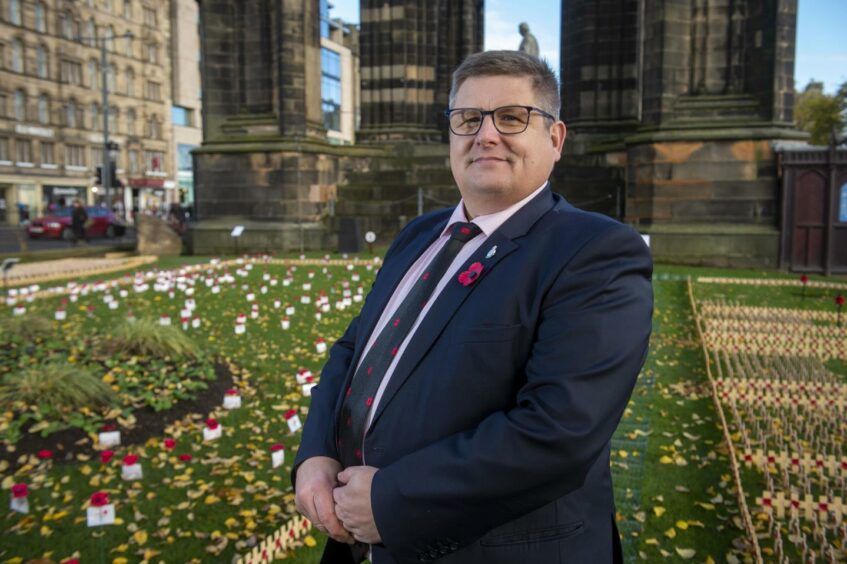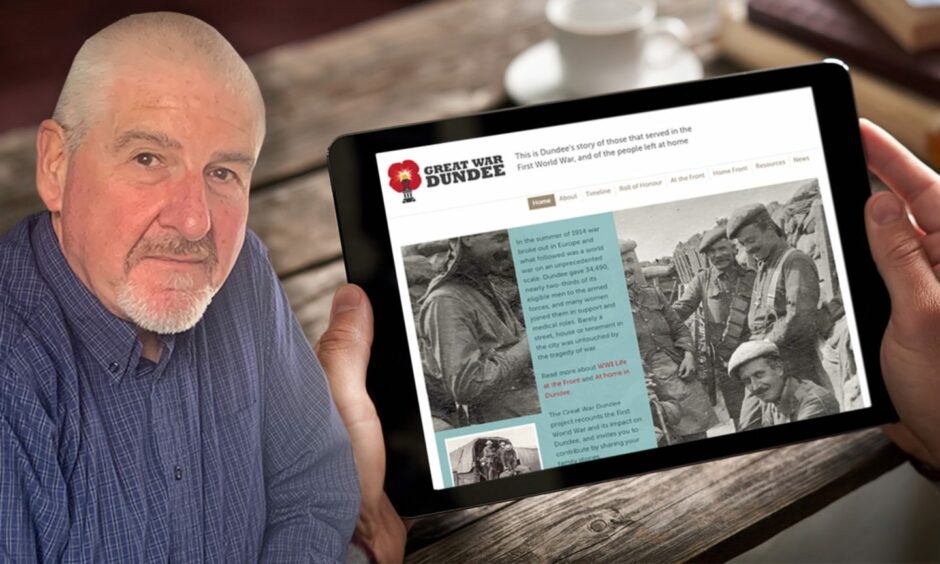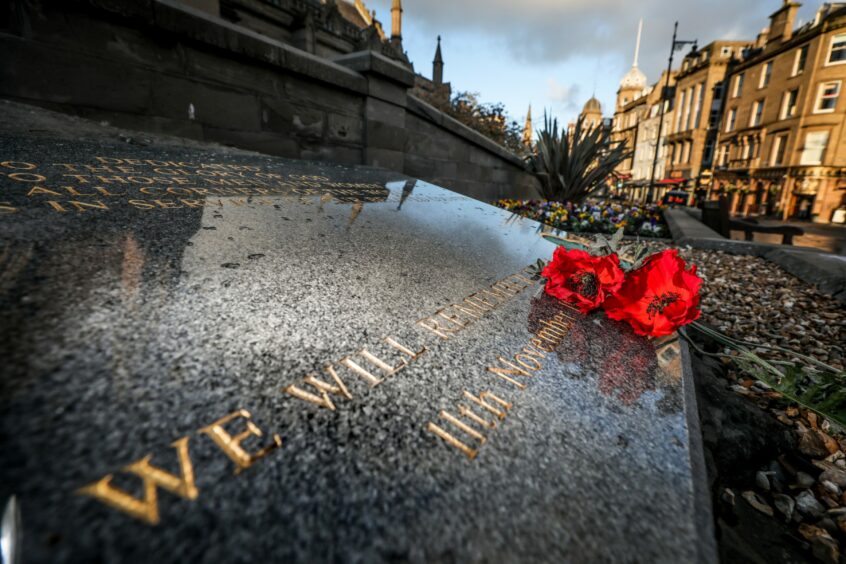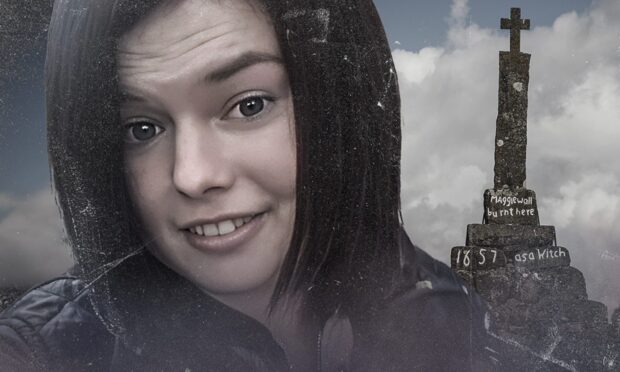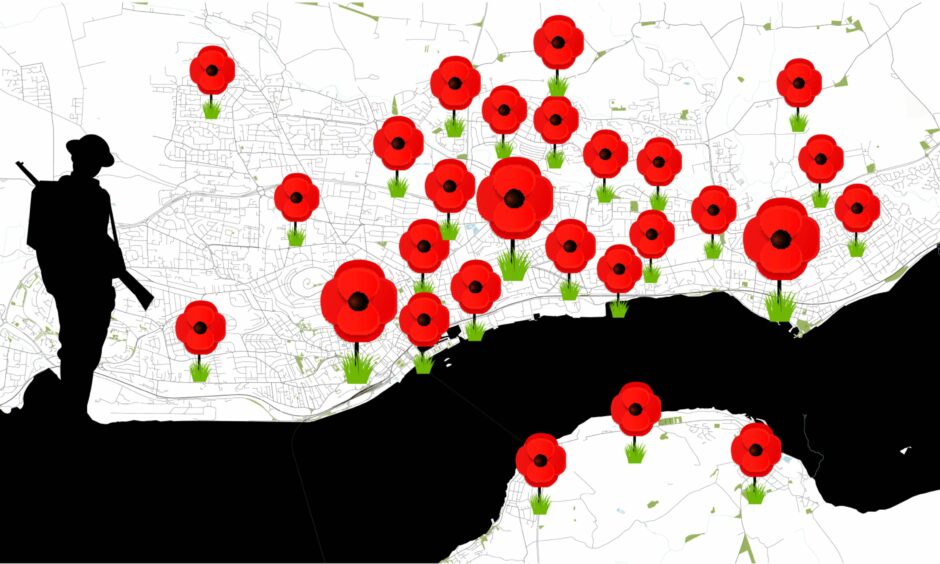
Each poppy on this map represents a Tayside life lost as a result of World War One.
From afar it may look like a field of poppies…
…but behind each one lies a unique story.
Alexander Cameron Brown was an artist at The Courier before going to war.
He was killed by a shell burst after leading his platoon to capture a portion of a German trench.
6,089 soldiers’ names are found in the Dundee roll of honour.
More than half of the deaths were amongst the lowest ranked privates…
Ten times more privates are found in the roll of honour than the next rank.
Many Tayside soldiers died each month that the war was raging.
November 11 marks 103 years since the end of the Great War. This year also marks the 100th anniversary of the poppy becoming a symbol of remembrance.
To mark the occasion, our interactive map and table pay tribute to Dundee WW1 victims who fought and lost their lives, sharing some of their stories and ensuring they continue to be remembered for years to come.
Every poppy tells the story of a WW1 victim
The map below has been created for Remembrance Day using Great War Dundee’s roll of honour. It includes addresses of those who died in and as a result of the First World War.
Not all locations may be exact, and not all entries could be included on the map. Due to the age of the data, not all addresses still exist. Other addresses were only recorded as a vague area.
Addresses were located for the map electronically, however many had to be corrected manually. If there’s any we have missed or if you spot any errors, let us know at datateam@dctmedia.co.uk
Every poppy represents an individual person who lost their life. Among those are a number of notable stories, including Dundee’s Victoria Cross recipient, Hugh McKenzie. He died at Passchendaele in October 1917 during an attack while capturing an enemy pill-box, and was posthumously awarded the VC on February 13, 1918.
Others show more tragedies for families, such as the Neil Family of 2 Kinnaird Street. Mother Susan Neil lost four sons in the First World War- James who died on May 15 1915, William who died on May 17, 1915, George Harrison who died on September 25, 1915 and Robert who died on May 7, 1919. Only one of the sons, Alexander, returned home safely.
Gordon Michie, head of fundraising and learning at Poppyscotland, said: “This map is a powerful reminder of how every single community has been impacted by the cost of conflict over the past 100 years. Each poppy symbolises the bravery and sacrifice of those who fought and died in defence of our nation.
“As we mark 100 years of the Scottish Poppy Appeal, it is imperative that we continue to remember and honour all of those who have served, those still serving, and their families.
“Just as the poppy is our national symbol of remembrance, for 100 years it has also served as a vital means for raising the funds needed to ensure our military personnel are not disadvantaged by their service.
“At Poppyscotland we work tirelessly to provide vital, life-changing support to our Armed Forces community. We are only able to do all this thanks to the continued generosity of the general public—each Poppy and each donation helps change a life.”
Any locations outside Tayside, including those in Canada, were removed for the above map; however, they are included in the table below.
Where did the Dundee roll of honour data come from?
Dundee’s roll of honour has been digitised by a group of volunteers at the Great War Dundee project. The group was formed to commemorate the first world war and the impact it had on the city.
Digitising World War One data
One of the people who is involved in the project is volunteer researcher Gary Thomson, from Broughty Ferry.
He said: “I started as a couple of my relatives were in the war, my mum showed me a photograph and said this is your great uncle, in the Canadian army. I did a wee bit of rummaging and found a lot of information.
“I found a lot of entries for the Canadian army, there was a lot of Dundee boys who joined. There was thousands and thousands of them from Tayside. They went for a better life. The men in Dundee were called kettle boilers because they didn’t have jobs, it was cheaper to employ women and they couldn’t find work. There was agents at the time from Canada encouraging people to emigrate.
The roll of honour was originally just a name, a number and a regiment, but these people had lives and families.”
Gary Thomson
“The original Dundee roll of honour was only partly done, names were wrong, there was the wrong number for the regiments, and it was missing loads. I’ve been updating it with all my own research, I’ve found another 2,000 Dundee boys who for some reason weren’t included, and there’s over 6,000 names on the roll of honour.
“I’m a volunteer researcher, but it’s turning into a bit of a full time job for me. I’ll probably never be finished. I’m always finding more things and adding them as and when.”
Gary believes it is important that those who served are remembered. He added: “The roll of honour was originally just a name, a number and a regiment, but these people had lives and families.
“A lot of people don’t think to look for these things. They hear stories from their parents, or their grandparents, and a lot of the time the stories grow arms and legs as they’re passed down but I want to put that into context and show people real information out there.
“It’s important to keep the memory alive, people move on and it’s sad to see. I’ll keep up doing this until I get told to stop.
“The majority of them were volunteers, they didn’t have a say in most of what went on and they should be remembered.”
Paying respects to Dundee’s WW1 soldiers
The digitised Dundee roll of honour also includes details of the locations of gravesites for those who fell in the war.
Not all of those who died have physical graves, some men’s bodies were never recovered. Others are simply named on memorials.
More than 365 men are remembered at the Thiepval Memorial in Hauts-de-France in northern France- which pays tribute to those who lost their lives during the Battle of the Somme between July and November 1916 and have no known grave.
A further 325 are named at the the Menin Gate Memorial in Ypres, and 311 at Le Touret Memorial. Another 274 are mentioned at the Loos Memorial, 242 at the Arres Memorial and 216 at the Tyne Cot Memorial.
More locally, there are 150 men memorialised at the Dundee Balgay Cemetery, and 147 at the Dundee Eastern Necropolis, now called the Dundee Eastern Cemetery.
